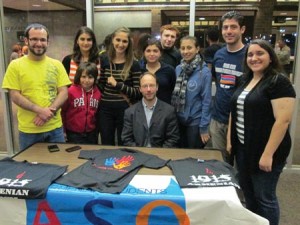Staff Report

Photo: Barlow Der Mugrdechian
The interconnectivity of the world is a characteristic of our age of globalism. While the pre-modern period did not witness an intensity of interaction comparable to our own, it nonetheless was interconnected. On April 16, Dr. Sergio La Porta, Haig and Isabel Berberian Chair of Armenian Studies at Fresno State, explored some of the areas of interaction between Armenians, Turks, and Georgians in the 12th through 14th centuries. He also demonstrated how Armenians were able to maintain a distinct cultural identity despite their lacking political sovereignty in Greater Armenia and their being dispersed throughout the Middle East.
Dr. La Porta’s lecture, entitled “Networks of Knowledge: Communication and Identity in 12th-14th c. Armenia,” focused on three topics: picturing Armenia, vectors of intercultural contact, and the identification of community markers. In the first part of his lecture, Dr. La Porta discussed the conquest of the Armenian kingdoms of the Bagratuni and the Arcruni by the Byzantine Empire. The Byzantines in turn were defeated by the Seljuk Turks in 1071 and Byzantine power in Armenia collapsed.
The destruction of the Armenian kingdoms by Byzantium, followed by the Turkish invasions helped remove an important element of the Armenian population from the region to other parts including Cilicia, caused the establishment of a number of Islamic dynasties, and changed the demographics of the area. Dr. La Porta also emphasized that we cannot look for hard boundaries between states in twelfth and thirteenth centuries. Rather than clean lines, he said, “we should imagine a series of points with radiating spheres of influence.” These points were urban centers such as Ani, Erzurum, and Erznka to mention a few.
Dr. La Porta then explained how trade routes connected these points and that a variety of people traveled along them. He suggested that these interconnections fostered the development of a ‘hybrid’ culture. By this term, Dr. La Porta explained, he meant “that a political, economic, and social language and culture emerged that was comprehensible to everyone in the region, regardless of faith or ethnicity.” He then provided examples from contemporary historical texts, inscriptions, and arts.
Finally, Dr. La Porta examined how Armenians in Greater Armenia and the dispersion were able to maintain a distinct common identity. He noted that the same routes that brought non-Armenians and Armenians into contact, also brought Armenians from different parts of the dispersion into communication. He pointed to sacred sites along the routes that were places of exchange between Armenians from different areas. He also remarked upon the efforts of the Armenian Church to try to stop a loss of cultural identity. In particular, he focused on how a core of texts helped form a common intellectual tradition among Armenian scholars. This tradition, he said, was later influential in the construction of an Armenian national identity.
Dr. La Porta’s lecture brought new light to the interconnectivity of cultures.
 Hye Sharzhoom Armenian Action
Hye Sharzhoom Armenian Action